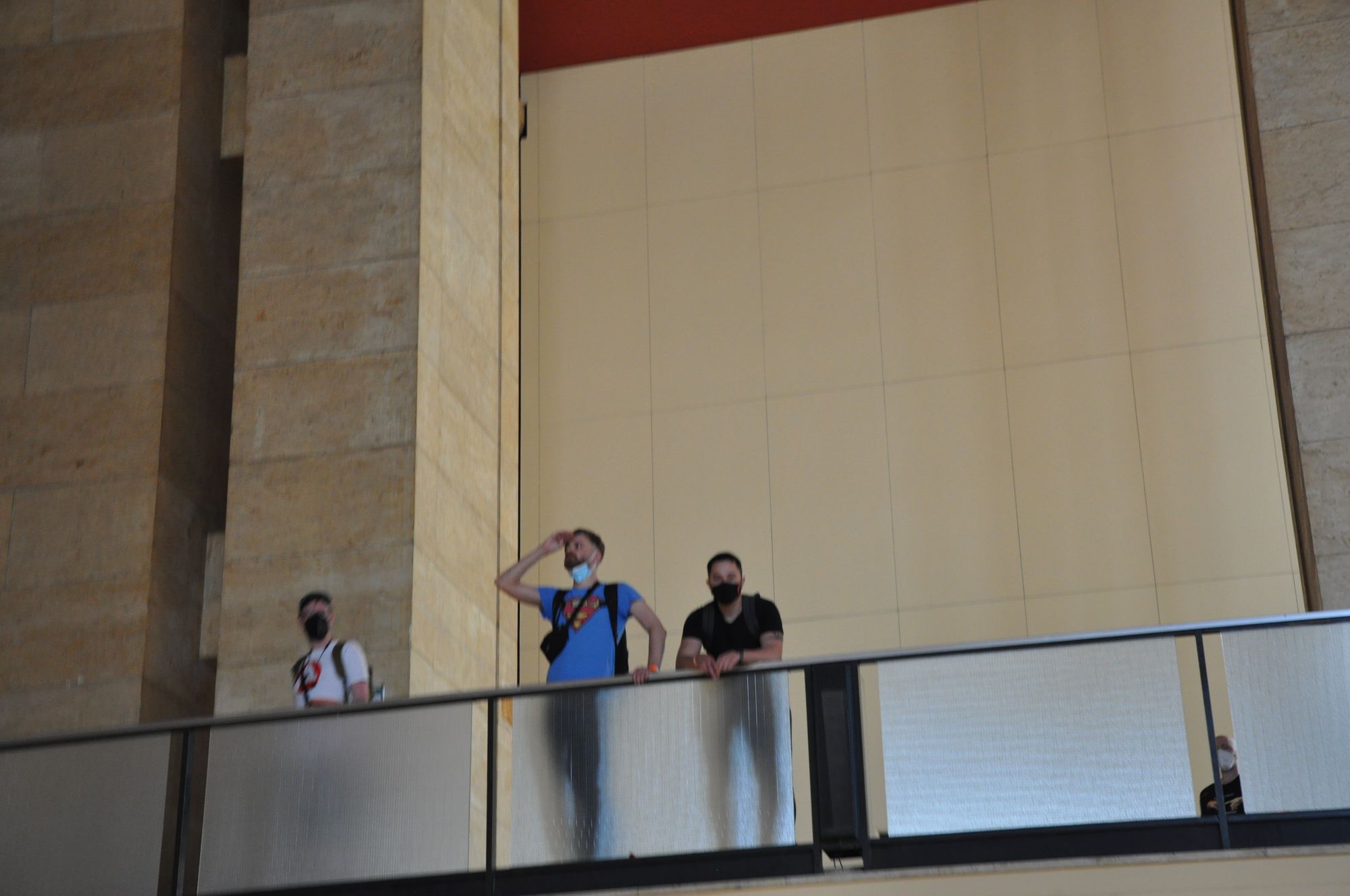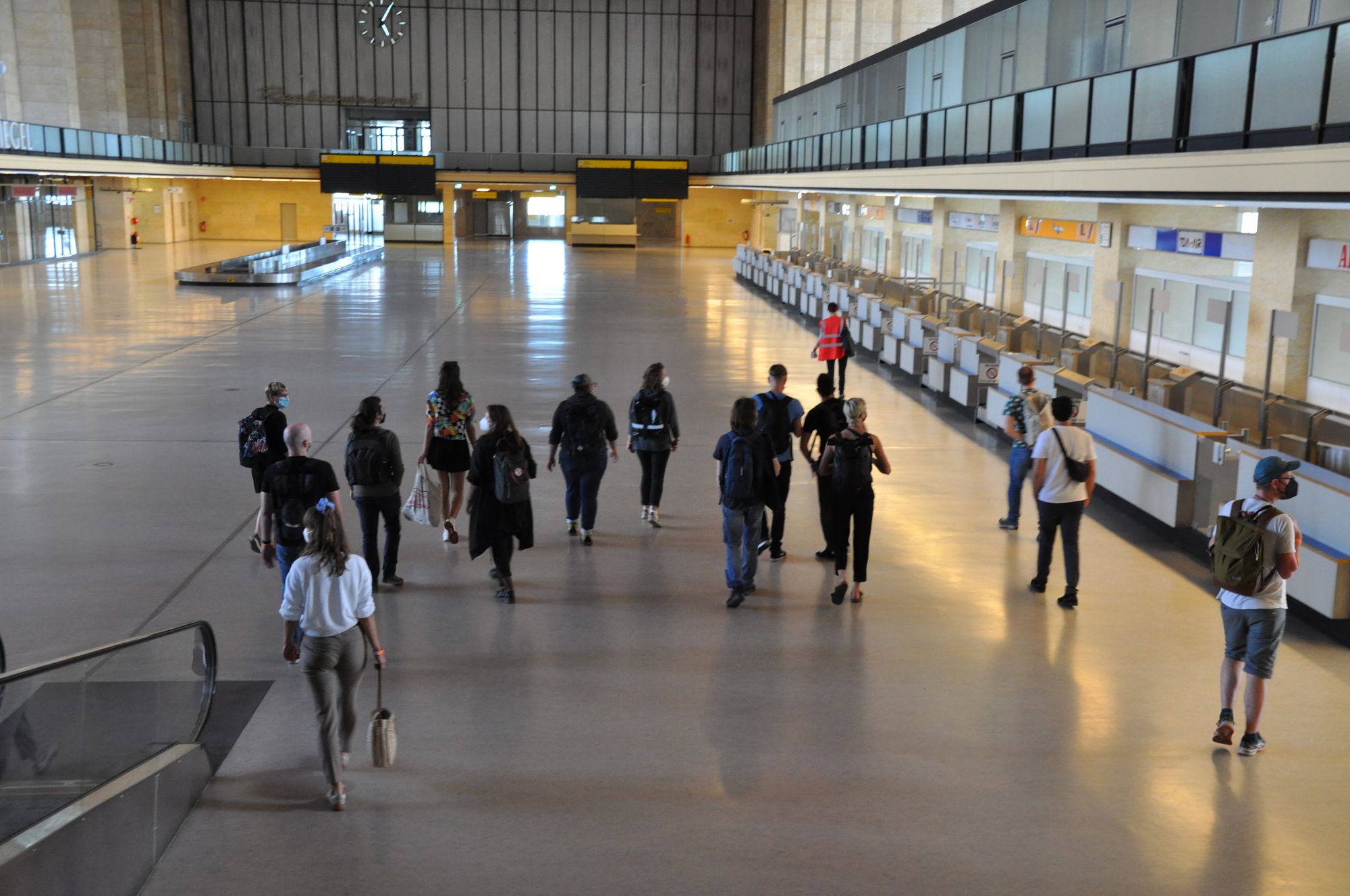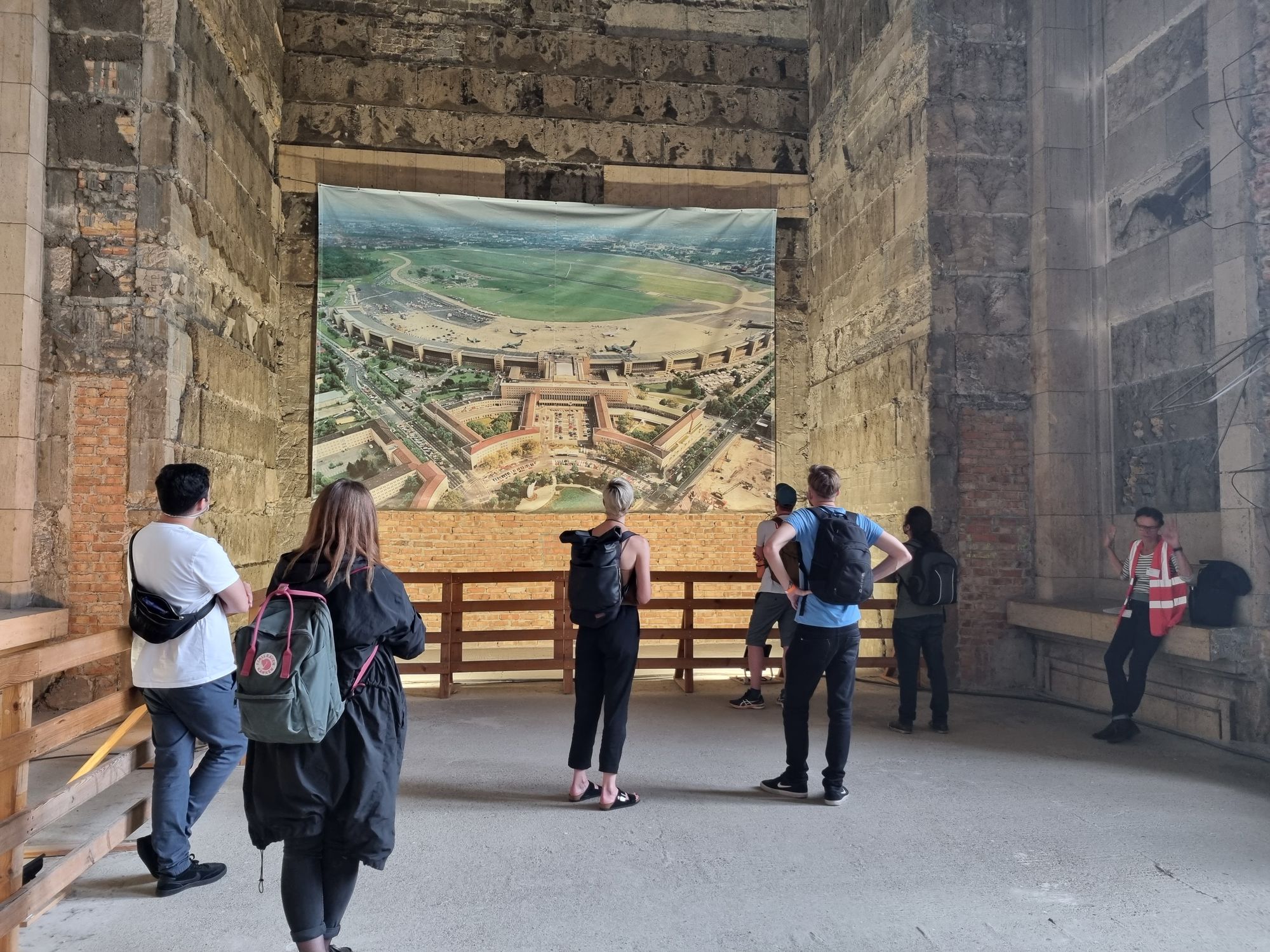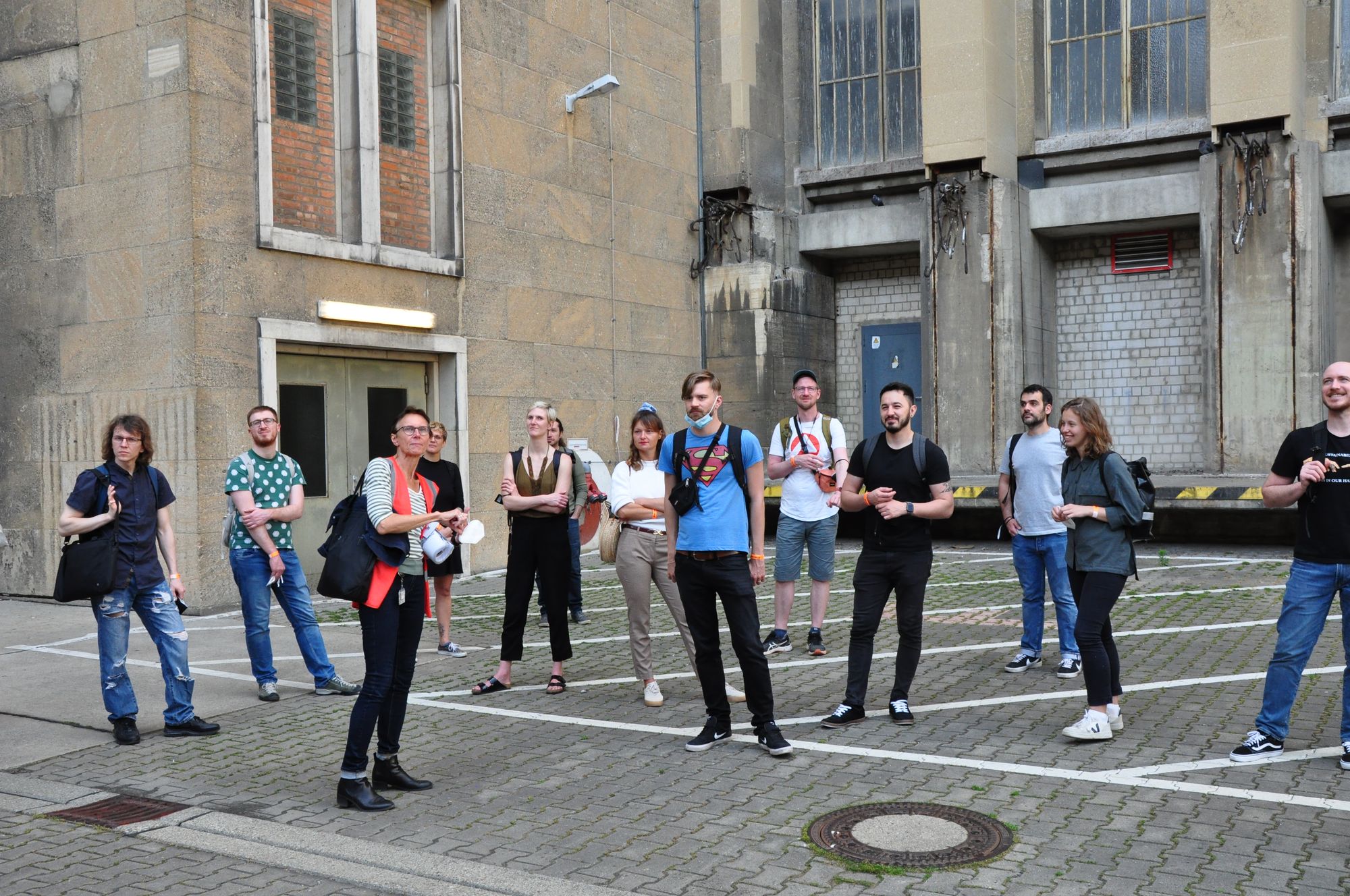Flughafen Tempelhof Visit

On June 8th this year, Summer starts with a field adventure to one of the iconic places in Berlin: the historic Tempelhof Airport. Some of us start the trip from the office, and like happy school children, we get on the U7 train to our destination. When we arrived at the building's entrance, we were full of energy and excitement, partly from the bright afternoon sun and partly from meeting in real life.
The front of the Tempelhof Airport is breathtaking, with a vast parking lot that matches the monumental facade upfront. The style matches the boxed-utilitarian style of the Nazi era, typical for government and military buildings from the 1920s and 1930s. On the right side was our gathering point a little before 17:00, where we met with Dr. Elke Dittrich, an architectural historian, and our tour guide.
Entrance
At first, we moved to the left side of the parking lot, where Dr. Dittrich mentioned that some offices for Die Polizei are located. She started saying her doctoral dissertation was about the building, so we knew we were up for premium content first-hand! From that point on, the guide was with the help of the book she wrote, in which we could see original photos of the airport. As she passed around the images, we asked questions about how Tempelhof impacted life in Berlin back then, for example: how far it was from the city, how the areas worked, how people used the installations, and much more.
Main Hallway
The tour was planned to last two hours, and our first access was to the front, into the main hallway where one can see the airline's area, on the ground floor. On each side of the hallway are the counters for the airlines, and the center keeps part of the original baggage claim belt.
The inner height to the ceiling of the main building was originally two-story high, making it as striking and monumental as it was intended in its design. The main hallway keeps the balconies that lead to the former restaurant and viewing areas.
Did you know? Back in the days of the war, the main hallway was also used as an assembly line for airplanes; even when the United States Army claimed Tempelhof, it also served this purpose, including as a place to organize the logistics to support their presence in this area of Berlin.
Upstairs and Restaurant
On the first floor, there is a waiting area decorated with paintings of people in the history of flight. There are also former office spaces and other rooms restricted to the public, however, the key attraction of this floor is the restaurant area. One of the concepts for the Tempelhof Airport was to show off the magnitude of flights taking off and landing; the big windows at the back of the restaurant help view the airfield, thus achieving this goal. From this area, people can see the entire field, including the plane rest-stops, the hangars, and the runways. Imagine this: in an era of pre-airport security, instead of going to an overpriced cafe shop, a Starbucks, or McDonald's, you could order a nice meal and sit in a proper restaurant while watching the airplanes fly during the sunset. Nowadays, many events are organized in this area, taking advantage of the size and easy access to the city.
Higher Floors and American Outpost
After the restaurant on the first floor, we headed to the higher floors where the American troops had their HQ. The Americans brought to Tempelhof many of their favorite past-times to make their troops feel at home. Besides working on post-war missions, they held events in a ballroom and sports including bowling, basketball, and volleyball on the same court, with their respective shower areas.
We had to go six floors up (I guess there were more restricted areas irrelevant to us tourists), to the part of the building modified for the entertainment of the US Air Force officials. We entered via a room with many long divisions, similar to long cubicles, that turned out to be dismantled bowling lanes.
The next room is a ballroom/dining area for officials where some festivities were held. According to urban legends, some officials could invite local girls as their dates... can you imagine the security process back then?! Today, the dining area has visual presentations with the story of the airport, models of the architecture, and a view of the airfield.
After a brief Q&A with Dr. Dittrich, we headed to the back of the dining area. There was access to the sports court, where the officials had the chance to play basketball and volleyball. It had a design similar to a small high school court, including the clock and scoreboard parts, modern for the time it was used. As we were twenty people, I think we could have played at least one-quarter of a match... but I doubt the tour guide would have liked it.
Did you know? One of the iconic basketball teams originally from Berlin was The Berlin Braves, a theme inspired by the Native Americans. It reminded me of the logo for the Atlanta Braves baseball team back in 1952.
Bunkers and Basement
For the last part, we headed to the opposing side of the airport complex and went downstairs. Our first stop was the "fake" first floor on top of the main entrance: as Tempelhof was designed both as an airport and a monument, the main hallway contained a high ceiling to see the art on the walls supporting the building. These days, instead of entering the airport and being in awe of these paintings, a concrete floor serves as the ceiling of the entrance. To see the art, you need to go through a maze on the first floor and see it. Currently, is being renovated to keep the structure as a cultural heritage, so only half of the "room" can be visited. It is a precious space as high as the downstairs area, and we should look forward to seeing it when everything is renovated.
Afterward, we descended to one of the darkest areas of the airport, both literally and figuratively. The bunkers used during the airstrikes in times of war are on the floors near the on-load and offload areas. Some parts of the bunkers are used today as storage units for former office furniture and documents, hidden behind enormous wooden crates. Among these crates, some entries to the bunkers are found locked. In order to enter and visit the actual bunkers, we had to go through another maze of doors, making the experience as intimidating as when the bunkers were needed.
We had the chance to get into the area with the original bunkers of wartime. The ones that were not renovated kept lightbulbs with dim light. The walls were decorated with Fraktur font (the old German font), with poems and phrases to lift up the mood of those who had to use the bunkers. Additionally, paintings of what were supposed to be good German families were plastered all over the walls. In some corners, there was access to water, and in others, access to chimney-like openings serving as air conditioning filters. According to our tour guide, approximately 30 to 60 people could fit into these rooms during an air strike. Thanks to the lack of light and the claustrophobic feeling, it is easy to understand the fear and uncertainty of anyone who had to be there during this period.
Although we went to the original bunkers as part of our tour experience, the guide noted that some bunkers were modified to improve the quality of life inside. We had the chance to visit part of one, but the same feeling could not go away.
Leaving
Our tour came to an end on the other side of the main entrance. Likewise the cargo vehicles, we walked from the bunkers to the outside area. For the entire time we were inside, we had to use masks due to Corona regulations, so the fresh air made an extra impact on all the history we just lived. Whether you were born in Berlin or not, the Tempelhof Airport brings you closer to the evolution of the city, seeing the scars of the past and the hope for the future. In short, the mix of legacy and reconstruction can be felt simultaneously in this tour visit. I recommend it to anyone who wants to feel closer to Berlin.




Thanks to Milan for coming up with the idea of visiting Tempelhof Airport, and to Anja for doing the logistics of taking us there. Let’s do it again in another historical part… What do you think should be our next spot to visit?
written by Liselot Ramirez, Software Developer